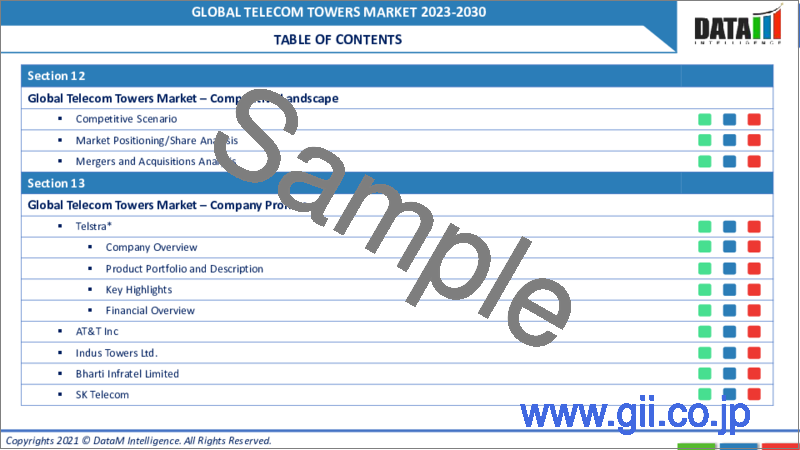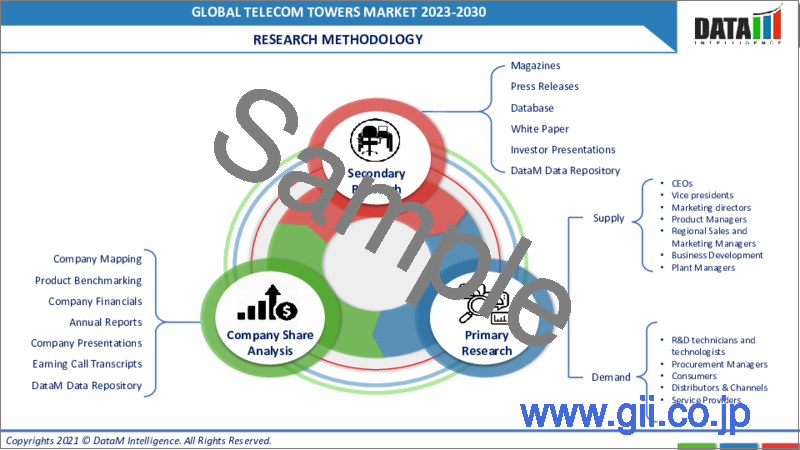|
|
市場調査レポート
商品コード
1176554
通信塔の世界市場-2023-2030Global Telecom Towers Market - 2023-2030 |
||||||
|
● お客様のご希望に応じて、既存データの加工や未掲載情報(例:国別セグメント)の追加などの対応が可能です。 詳細はお問い合わせください。 |
|||||||
| 通信塔の世界市場-2023-2030 |
|
出版日: 2022年12月26日
発行: DataM Intelligence
ページ情報: 英文 180 Pages
納期: 即日から翌営業日
|
- 全表示
- 概要
- 目次
市場概要
通信塔市場は、2023年から2030年にかけてCAGR 9.0%で成長すると予測されています。
市場力学
通信塔は、通信や放送のアンテナを収容する鉄骨構造物群です。モバイルネットワーク、テレビアンテナ、無線伝送などの無線通信は、すべて通信塔によって接続されています。タワーシェアリングは、コスト削減やデータ展開の迅速化などのメリットをもたらすため、通信事業における最も重要な展開の一つとなっています。
スマートフォンやインターネットユーザーの普及が進んでいることも、世界の通信塔市場の主要な促進要因となっています
スマートフォンユーザーの増加に伴い、世界の通信塔の分野も上昇すると予想されます。携帯電話ユーザーは、ほとんどすべての遠隔地で増加しており、より良いネットワークカバレッジを提供するためにサービスプロバイダー間の競争が激化しています。さらに、電話サービスプロバイダー、インターネットサービスプロバイダ、Wi-Fi、ブロードバンドサービスプロバイダの増加が、予測期間中の世界の通信塔市場の成長を促進すると予測されています。
設置や運用にかかる高いコストが、通信塔の世界市場を抑制すると予測されます
自治体や地方公共団体が課す高額な認可料により、タワーの設置コストは急騰しています。更新料、共有料、開発料などの名目で複数の税金が課されますが、これらはすべて政府の収入を増やすためだけのものです。リース料は月々数百ドルから数万米ドルにもなります。立地条件、標高、他のタワーとの距離、人口密集地かどうか、交通量が多いかどうか、地域のゾーニング規則などがリース料に影響します。高い設置費用と運用費用が、世界の通信塔市場の成長を妨げると予想されます。
現在進行中の5Gネットワークへの移行は、世界の通信塔市場に新たな機会を生み出すと予想されます
現在、世界では4G通信ネットワークから5G通信ネットワークへの移行が進んでいます。5Gは、4Gよりも高速で信頼性の高いネットワークサービスを提供することが期待されています。潜在的なアプリケーションの数が多いため、5Gネットワーク技術を円滑に機能させるためには、通信塔の高密度ネットワークが必要とされます。5Gネットワークへの移行が進んでいることから、世界の通信塔市場の機会を大きく押し上げると予想されます。
高周波電波の有害な影響に関する懸念の高まりは、世界市場に課題をもたらすと予想されます
通信塔は、常に環境に悪影響を及ぼしてきました。モバイルタワーの放射は常に問題視されており、現在では目に見えない微妙な汚染物質として認識され、生命体に様々な影響を与える可能性があります。通信塔が発する電磁波は、人間や野生生物にさまざまな影響を及ぼします。放射線の影響により、動物の個体数が減少したり、放射線源付近の植物の健康状態が悪化したりすることがあります。高周波電波の有害な影響に対する懸念の高まりは、世界の通信塔市場の成長にとって大きな課題となるでしょう。
COVID-19インパクト分析
世界の通信塔市場はCOVID-19の大流行による影響を受けました。タワーの設置に使用される基礎資材のサプライチェーンがパンデミックにより混乱しました。ロックダウンや移住による人手不足が発生し、保守作業の遂行が困難になり、市場が不安定になったため、タワー建設プロジェクトの遅延による巨額の損失が発生しました。世界の通信塔市場は、ロックダウンの影響をもろに受けています。パンデミックは、世界の通信塔市場の長期的な成長に影響を与えないと予想されます。
業界における最近の動向
2022年7月、インドの通信省(DoT)は、5G技術規格への移行に向けた通信塔のバックホール化を発表しました。
2022年7月、VodafoneはTelecom Italiaと提携し、イタリアの地方で5Gをカバーするための通信塔を建設しました。
目次
第1章 通信塔の世界市場- 調査手法と調査範囲
- 調査手法
- 調査目的と調査範囲
第2章 通信塔の世界市場-市場の定義と概要
第3章 通信塔の世界市場-エグゼクティブサマリー
- 燃料別市場内訳
- タイプ別市場内訳
- 設置場所別市場内訳
- 所有者別市場内訳
- 地域別市場内訳
第4章 通信塔の世界市場-市場力学
- 市場影響要因
- 促進要因
- タワー共有の増加は、通信塔市場の重要な促進要因の一つである
- 抑制要因
- 高周波電波の有害性に関連する懸念の高まり
- ビジネスチャンス
- 影響分析
- 促進要因
第5章 通信塔の世界市場- 産業分析
- ポーターのファイブフォース分析
- サプライチェーン分析
- 価格設定分析
- 規制分析
第6章 通信塔の世界市場-COVID-19分析
- COVID-19の市場分析
- COVID-19登場前の市場シナリオ
- COVID-19の現在の市場シナリオ
- COVID-19以降、または今後のシナリオ
- COVID-19の中での価格ダイナミクス
- 需要-供給スペクトラム
- パンデミック時の市場に関連する政府の取り組み
- メーカーの戦略的な取り組み
- まとめ
第7章 通信塔の世界市場-燃料別
- 再生可能
- 非再生可能
第8章 通信塔の世界市場-タイプ別
- ガイアードタワー
- ステルスタワー
- モバイルセルタワー
- モノポールタワー
- ラティスタワー
第9章 通信塔の世界市場-設置場所別
- 地上設置型
- 屋上設置型
第10章 通信塔の世界市場-所有者別
- 個人所有
- 移動体通信事業者所有
- ジョイントベンチャー
- 事業者所有
第11章 通信塔の世界市場-地域別
- 北米
- 米国
- カナダ
- メキシコ
- 欧州
- ドイツ
- 英国
- フランス
- イタリア
- ロシア
- その他欧州
- 南米
- ブラジル
- アルゼンチン
- その他の南米地域
- アジア太平洋地域
- 中国
- インド
- 日本
- オーストラリア
- その他アジア太平洋地域
- 中東・アフリカ地域
第12章 通信塔の世界市場- 競争情勢
- 競合シナリオ
- 市況分析/シェア分析
- M&A(合併・買収)分析
第13章 通信塔の世界市場-企業プロファイル
- Telstra
- 企業概要
- 製品ポートフォリオと説明
- 主なハイライト
- 財務概要
- AT&T Inc
- Indus Towers Ltd.
- Bharti Infratel Limited
- SK Telecom
- American Tower Corporation
- Icomm Tele Limited.
- Mahanagar Telephone Nigam Ltd
- Helios Towers Africa
- Verizon
第14章 通信塔の世界市場-重要考察
第15章 通信塔の世界市場- DataM
Market Overview
Telecom Towers Market was valued at US$ XX billion in 2022; it is projected to reach US$ XX billion by 2030, with growth at a CAGR of 9.0% over the forecast period 2023-2030.
Market Dynamics
Telecommunication towers are a group of steel structures that house telecommunications and broadcasting antennas. Wireless communication, such as mobile networking, television antennae and radio transmission, are all connected by telecom towers. Tower-sharing is one of the most important developments in the telecom business, as it provides benefits such as cost savings and faster data rollout.
Increasing penetration of smartphone and internet users is a major driver for the global telecom towers market:
The global telecom towers sector is expected to rise as the number of smartphone users increases. Mobile phone users are growing in almost every remote location, increasing competition among service providers to provide better network coverage. Furthermore, an increasing number of telephone service providers, internet service providers, Wi-Fi and broadband service providers are predicted to drive the growth of the global telecom towers market over the forecast period.
High costs of installation and operation are expected to restrain the global telecom towers market:
Due to high authorization fees imposed by municipal corporations and local governments globally, tower installation costs have skyrocketed. Multiple taxes masquerading as renewal fees, sharing fees and development fees are charged, all with the sole intention of boosting government revenue. Lease costs range from hundreds of dollars per month to tens of thousands of dollars per month. The site's location, its elevation, the distance to other towers, if there is a dense population or heavy traffic nearby and local zoning rules all influence the leasing rate. High installation and operation costs are expected to prevent the growth of the global telecom towers market.
The ongoing transition to 5G networks is expected to generate new opportunities for the global telecom towers market:
Currently, the world is transitioning from 4G to 5G communication networks. 5G is expected to provide faster speeds and more reliable network service over 4G. Due to a large number of potential applications, a denser network of telecom towers is required for the smooth functioning of 5G network technology. The ongoing transition to 5G networks is expected to significantly boost the opportunities for the global telecom towers market.
Growing concerns about the harmful effects of high-frequency radio waves are expected to present challenges for the global market:
Telecom towers have always had an adverse environmental impact. Mobile tower radiation has always been an issue and it is now recognized as an unseen and subtle pollutant that may have various effects on life forms. The electromagnetic radiation emitted by telecom towers has various effects on humans and wildlife. As a result of radiation, animal populations may decline and the health of plants near radiation sources may worsen. Growing concerns about the harmful effects of high-frequency radio waves will be a major challenge for the growth of the global telecom towers market.
COVID-19 Impact Analysis
The global telecom towers market was affected by the COVID-19 pandemic. The supply chain for the fundamental materials used in tower installation was disrupted due to the pandemic. There was a staffing shortage due to lockdowns and migrations, leading to difficulty in executing maintenance operations and market instability resulting in massive losses due to tower construction project delays. The global telecom tower market has borne the brunt of the lockdowns. The pandemic is not expected to impact the long-term growth of the global telecom towers market.
Recent Developments in the Industry:
In July 2022, India's department of telecommunications (DoT) announced the backhaul of telecom towers in preparation for the transition to 5G technology standards.
In July 2022, Vodafone partnered with Telecom Italia to build telecom towers for 5G coverage in rural Italy.
Market Segmentation:
The scope of the report covers segmentation based on fuel, type, installation, ownership type and region. The global telecom towers market is segmented by fuel into renewable and non-renewable. The global telecom towers market is segmented by type into guyed towers, stealth towers, mobile cell towers, monopole towers and lattice towers. The global telecom towers market is segmented by installation into ground-based and rooftop. The global telecom towers market is segmented by ownership type into privately owned, mobile network operator-owned, joint venture and operator owned. The global telecom towers market is segmented by region into North America, South America, Europe, Asia-Pacific, Middle East and Africa.
Guyed Tower: Guyed towers are part of the telecommunication infrastructure network. These towers are backed by cables to stabilize the tower and are located in a wide geographical area to improve signal coverage and extend network services. A guyed tower is a light- to heavy-weight communication tower formed with straight rods aligned in a triangular pattern but supported with wires at all angles. Guyed towers are particularly tall, attaining heights as high as 2,000 feet and are typically employed to support antennas high off the ground, providing greater signal strength and cell reception.
Stealth Tower: Stealth towers are widely deployed to satisfy zoning regulations. They are more costly than other towers because they need additional materials to build a concealed appearance. Their smaller also size typically causes them less efficiency. This type of structure is applied whenever there may be a requirement to hide a tower in plain sight. They are produced to ensure that the towers blend in with their surroundings. These towers can shape many other objects, such as signs and flagpoles.
Mobile Cell Tower: Mobile cell towers, also known as cells on wheels, are recognized as low-profile and portable towers because they are often installed on trailers. The towers are portable, small footprint, discreet and versatile. They are often used in temporary or emergencies; however, they are useful if funds or permits are concerned.
Monopole Tower: A monopole is a single pole built from galvanized metal sections stacked on top of each other to achieve the necessary height. Typically the tower has a sleeker look than a lattice tower and ranges from 50 feet to 175 feet. Because of the instability of using a single pole, the length of these structures cannot surpass 200 feet. The application of monopole towers is suitable when space is limited.
Lattice Tower: The lattice towers are also called "self-supporting towers" and are typically constructed in triangular or square shapes. These towers have the utmost stability and flexibility associated with other cell tower types.
Regional Classification:
According to the DataM Intelligence market research report, the global Telecom towers market is divided into North America, South America, Europe, Asia-Pacific, Middle East and Africa.
U.S. market is turned out to be one of the most competitive landscapes for major vendors offering their services globally. Many companies are investing major chunks in establishing their business in U.S. market, with growing demand for 5G telecom. In recent years, mobile wireless services have been the largest and fastest-growing sector of the telecommunications industry in Canada. The ongoing transition to 5G and adoption of emerging technologies such as IoT is expected to boost the growth of the North American telecom towers market.
Germany has one of Europe's largest telecom marketplaces, with several major carriers providing robust competition in the mobile and broadband sectors. Mobile carriers in other major countries in the region, such as France and UK, are installing new telecom towers to expand coverage in underserved areas. The expanding adoption of telecom towers will drive the growth of the European telecom towers market.
Asia-Pacific has had one of the fastest rates of adoption of smartphone and internet users. China is one of the region's biggest markets for telecom towers and the country is constructing many towers for the ongoing transition to 5G standards. India has become one of the world's fastest-growing digital economies and the greatest data consumer in the last decade. The telecom tower sector has been a driving force behind the internet revolution in the country. The fast smartphone penetration rate in major countries such as China and India will be the major factor in driving the growth of the Asia-Pacific telecom towers market.
Competitive Analysis:
The global telecom towers market is fragmented, with major international players having a large market share. The major players are adopting various strategies to dominate the market, such as launching new technologies, acquisitions, regional and international expansion and collaborations.
Major Companies:
Some key companies contributing to the global Telecom towers market growth include Telstra, AT&T Inc, Indus Towers Ltd., SK Telecom, American Tower Corporation, Bharti Infratel Limited, Icomm Tele Limited. Helios Towers Africa, Verizon, Aster Pvt Ltd. and SBA Communications Corporation, among others.
Table of Contents
1. Global Telecom Towers Market - Methodology and Scope
- 1.1. Research Methodology
- 1.2. Research Objective and Scope of the Report
2. Global Telecom Towers Market - Market Definition and Overview
3. Global Telecom Towers Market - Executive Summary
- 3.1. Market Snippet by Fuel
- 3.2. Market Snippet by Type
- 3.3. Market Snippet by Installation
- 3.4. Market Snippet by Ownership
- 3.5. Market Snippet by Region
4. Global Telecom Towers Market-Market Dynamics
- 4.1. Market Impacting Factors
- 4.1.1. Drivers
- 4.1.1.1. Increasing tower sharing is one of the significant market driving factors for telecom tower market
- 4.1.1.2. XX
- 4.1.2. Restraints
- 4.1.2.1. Growing concerns related to the harmful effects of high-frequency radio waves
- 4.1.2.2. XX
- 4.1.3. Opportunity
- 4.1.3.1. XX
- 4.1.4. Impact Analysis
- 4.1.1. Drivers
5. Global Telecom Towers Market - Industry Analysis
- 5.1. Porter's Five Forces Analysis
- 5.2. Supply Chain Analysis
- 5.3. Pricing Analysis
- 5.4. Regulatory Analysis
6. Global Telecom Towers Market - COVID-19 Analysis
- 6.1. Analysis of COVID-19 on the Market
- 6.1.1. Before COVID-19 Market Scenario
- 6.1.2. Present COVID-19 Market Scenario
- 6.1.3. After COVID-19 or Future Scenario
- 6.2. Pricing Dynamics Amid COVID-19
- 6.3. Demand-Supply Spectrum
- 6.4. Government Initiatives Related to the Market During Pandemic
- 6.5. Manufacturers Strategic Initiatives
- 6.6. Conclusion
7. Global Telecom Towers Market - By Fuel
- 7.1. Introduction
- 7.1.1. Market Size Analysis and Y-o-Y Growth Analysis (%), By Fuel
- 7.1.2. Market Attractiveness Index, By Fuel
- 7.2. Renewable*
- 7.2.1. Introduction
- 7.2.2. Market Size Analysis and Y-o-Y Growth Analysis (%)
- 7.3. Non-Renewable
8. Global Telecom Towers Market - By Type
- 8.1. Introduction
- 8.1.1. Market Size Analysis and Y-o-Y Growth Analysis (%), By Type
- 8.1.2. Market Attractiveness Index, By Type
- 8.2. Guyed Towers*
- 8.2.1. Introduction
- 8.2.2. Market Size Analysis and Y-o-Y Growth Analysis (%)
- 8.3. Stealth Towers
- 8.4. Mobile Cell Towers
- 8.5. Monopole Towers
- 8.6. Lattice Tower
9. Global Telecom Towers Market - By Installation
- 9.1. Introduction
- 9.1.1. Market Size Analysis and Y-o-Y Growth Analysis (%), By Installation
- 9.1.2. Market Attractiveness Index, By Installation
- 9.2. Ground-Based*
- 9.2.1. Introduction
- 9.2.2. Market Size Analysis and Y-o-Y Growth Analysis (%)
- 9.3. Rooftop
10. Global Telecom Towers Market - By Owner Ship
- 10.1. Introduction
- 10.1.1. Market Size Analysis and Y-o-Y Growth Analysis (%), By Ownership
- 10.1.2. Market Attractiveness Index, By Ownership
- 10.2. Private Owned*
- 10.2.1. Introduction
- 10.2.2. Market Size Analysis and Y-o-Y Growth Analysis (%)
- 10.3. Mobile Network Operator Owned
- 10.4. Joint Venture
- 10.5. Operator Owned
11. Global Telecom Towers Market - By Region
- 11.1. Introduction
- 11.1.1. Market Size Analysis and Y-o-Y Growth Analysis (%), By Region
- 11.1.2. Market Attractiveness Index, By Region
- 11.2. North America
- 11.2.1. Introduction
- 11.2.2. Key Region-Specific Dynamics
- 11.2.3. Market Size Analysis and Y-o-Y Growth Analysis (%), By Fuel
- 11.2.4. Market Size Analysis and Y-o-Y Growth Analysis (%), By Type
- 11.2.5. Market Size Analysis and Y-o-Y Growth Analysis (%), By Installation
- 11.2.6. Market Size Analysis and Y-o-Y Growth Analysis (%), By Ownership
- 11.2.7. Market Size Analysis and Y-o-Y Growth Analysis (%), By Country
- 11.2.7.1. U.S.
- 11.2.7.2. Canada
- 11.2.7.3. Mexico
- 11.3. Europe
- 11.3.1. Introduction
- 11.3.2. Key Region-Specific Dynamics
- 11.3.3. Market Size Analysis and Y-o-Y Growth Analysis (%), By Fuel
- 11.3.4. Market Size Analysis and Y-o-Y Growth Analysis (%), By Type
- 11.3.5. Market Size Analysis and Y-o-Y Growth Analysis (%), By Installation
- 11.3.6. Market Size Analysis and Y-o-Y Growth Analysis (%), By Ownership
- 11.3.7. Market Size Analysis and Y-o-Y Growth Analysis (%), By Country
- 11.3.7.1. Germany
- 11.3.7.2. UK
- 11.3.7.3. France
- 11.3.7.4. Italy
- 11.3.7.5. Russia
- 11.3.7.6. Rest of Europe
- 11.4. South America
- 11.4.1. Introduction
- 11.4.2. Key Region-Specific Dynamics
- 11.4.3. Market Size Analysis and Y-o-Y Growth Analysis (%), By Fuel
- 11.4.4. Market Size Analysis and Y-o-Y Growth Analysis (%), By Type
- 11.4.5. Market Size Analysis and Y-o-Y Growth Analysis (%), By Installation
- 11.4.6. Market Size Analysis and Y-o-Y Growth Analysis (%), By Ownership
- 11.4.7. Market Size Analysis and Y-o-Y Growth Analysis (%), By Country
- 11.4.7.1. Brazil
- 11.4.7.2. Argentina
- 11.4.7.3. Rest of South America
- 11.5. Asia-Pacific
- 11.5.1. Introduction
- 11.5.2. Key Region-Specific Dynamics
- 11.5.3. Market Size Analysis and Y-o-Y Growth Analysis (%), By Fuel
- 11.5.4. Market Size Analysis and Y-o-Y Growth Analysis (%), By Type
- 11.5.5. Market Size Analysis and Y-o-Y Growth Analysis (%), By Installation
- 11.5.6. Market Size Analysis and Y-o-Y Growth Analysis (%), By Owner Ship
- 11.5.7. Market Size Analysis and Y-o-Y Growth Analysis (%), By Country
- 11.5.7.1. China
- 11.5.7.2. India
- 11.5.7.3. Japan
- 11.5.7.4. Australia
- 11.5.7.5. Rest of Asia-Pacific
- 11.6. Middle East and Africa
- 11.6.1. Introduction
- 11.6.2. Key Region-Specific Dynamics
- 11.6.3. Market Size Analysis and Y-o-Y Growth Analysis (%), By Fuel
- 11.6.4. Market Size Analysis and Y-o-Y Growth Analysis (%), By Type
- 11.6.5. Market Size Analysis and Y-o-Y Growth Analysis (%), By Installation
- 11.6.6. Market Size Analysis and Y-o-Y Growth Analysis (%), By Ownership
12. Global Telecom Towers Market - Competitive Landscape
- 12.1. Competitive Scenario
- 12.2. Market Positioning/Share Analysis
- 12.3. Mergers and Acquisitions Analysis
13. Global Telecom Towers Market- Company Profiles
- 13.1. Telstra*
- 13.1.1. Company Overview
- 13.1.2. Product Portfolio and Description
- 13.1.3. Key Highlights
- 13.1.4. Financial Overview
- 13.2. AT&T Inc
- 13.3. Indus Towers Ltd.
- 13.4. Bharti Infratel Limited
- 13.5. SK Telecom
- 13.6. American Tower Corporation
- 13.7. Icomm Tele Limited.
- 13.8. Mahanagar Telephone Nigam Ltd
- 13.9. Helios Towers Africa
- 13.10. Verizon
LIST NOT EXHAUSTIVE
14. Global Telecom Towers Market - Premium Insights
15. Global Telecom Towers Market - DataM
- 15.1. Appendix
- 15.2. About Us and Services
- 15.3. Contact Us




